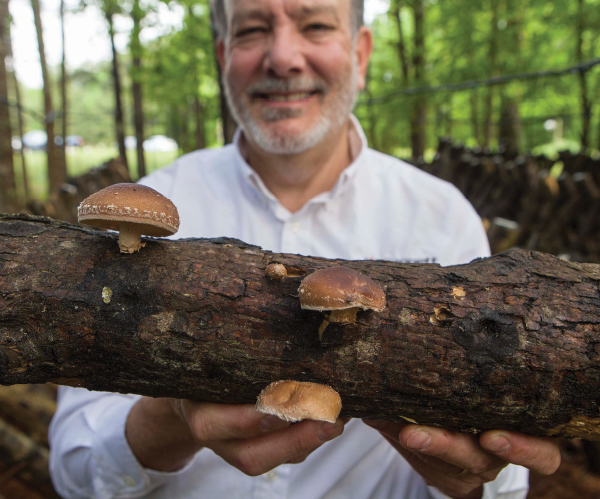In honor of National Mushroom Month, here’s an inside look at nature’s most distinctive edible fungi.
When it comes to flavor, versatility and nutritional value, there’s no denying that mushrooms have become a rock-star ingredient in kitchens far and wide. Among the assorted types available, some of the most sought-after species from chefs and foodies alike are heirloom mushrooms like shiitake, oyster and lion’s mane.
So how is it that these subtle, earthy elements have risen to such well-regarded heights?
Terry and Brenda Winebrenner, cultivators of shiitake mushrooms at their bucolic 13-acre Heathwood Farm in New Hill, can answer that question.

“We have 300 logs in production, but since we rely on nature and grow the mushrooms outside, we don’t harvest during the warm summer months.” — Brenda Winebrenner
“We love mushrooms because they are so healthy, hearty and delicious,” said
Brenda. Since 2013, the couple has grown the dark-brown, exotic variety.
The process involves meticulously inoculating sweet gum tree logs situated under a shaded canopy.
“We have a special drill bit that we use to bore holes in the log, and then we use an inoculator to inject the spawn, which is contained in a sawdust mixture,” Brenda explained. “We cover each hole with a food-grade cheese wax so the spawn stays alive and starts eating within the log.”
The Winebrenners source shiitakes to farm-to-table restaurant Little Hen in Apex. They formerly sold to Lucky 32 Southern Kitchen and other local eateries, but didn’t want to “overpromise and under deliver,” Terry said, since the harvest varies depending on the climate.
“We have 300 logs in production, but since we rely on nature and grow the mushrooms outside, we don’t harvest during the warm summer months,” said Brenda. The farm typically yields more than150 pounds of shiitakes each year.

Jonathan Graham displays oyster mushrooms grown in his home basement. He sells his crop at the State Farmer’s Market in Raleigh.
“Mushrooms give off a satisfying umami response that comes from their high levels of glutamate,” Terry explained. “Shiitakes function as a nice substitute for meat without sacrificing flavor. We eat them quite often, and they are particularly enjoyable in soup.”
On the other side of Wake County, Garner resident Jonathan Graham grows and sells various types of mushrooms though his Graham’s Groceries enterprise.
“I mainly produce shiitake, oyster and lion’s mane mushrooms and sell them on the weekends at the State Farmer’s Market in Raleigh,” said Graham, a retired Army veteran who has been in the harvesting business for three years.
Graham spent months conducting research online and even visited several mushroom farms in Wisconsin to hone his skills. In addition to growing mushrooms on tree logs, Graham also produces them in his humidity-controlled home basement.
“There’s a lot involved in this craft that keeps most people from pursuing it,” Graham said. “I use bags of straw that have to be pasteurized, and then mycelium is mixed in. I produce roughly between 400 to 500 pounds of mushrooms each year.”

Brenda Winebrenner cuts and prepares fresh shiitakes.

Sautéed mushrooms can be served with grilled meats or they can stand alone in vegetarian dishes.
Graham said he prefers the taste of shiitake, oyster and lion’s man over species like portabella, cremini and white button mushrooms, the latter of which are easier to find in the vegetable section at a typical grocery store. When cooked, the taste and texture of shiitake mushrooms, according to Graham, is similar to chicken, while lion’s mane compares favorably to lobster.
“If you haven’t tried lion’s mane, you’ve been missing out on a great flavor profile,” he said.
In addition to adding a low-calorie, meaty taste to vegetarian dishes, mushrooms also provide nutrient-rich antioxidants, minerals such as potassium, and vitamins B and D.
You don’t have to be a culinary school-trained chef to cook with mushrooms. Just follow these simple guidelines for storing, serving and preparing.
- Transfer fresh heirloom mushrooms purchased at the farmer’s market or gourmet grocery to a paper bag or damp cloth sack and store in the refrigerator. The mushrooms will remain firm and usable for up to two weeks.
- Just prior to using, gently clean each mushroom with a damp paper towel, cloth or soft vegetable brush to remove any dirt.
- In a large skillet (preferably cast iron), heat olive oil or butter over medium-high heat. Once oil is hot or butter is melted, cook the mushrooms for about five minutes, stirring occasionally with a spatula or wooden spoon. Cook until lightly brown. Sautéed mushrooms can be frozen for up to nine months. Thaw for a quick pizza topping or omelet filling.
- Add mushrooms to spaghetti sauce, salads, casseroles, vegetable-centric dishes or atop grilled steak, pork or chicken. You can also serve them as a bistro-style side item.

Bucatini with Shiitake Mushrooms
By Regan Stachler, executive chef and owner, Little Hen Restaurant
Serves 4
I pound bucatini or other dried pasta
1 pound shiitake mushrooms, sliced
1/2 pound thick-cut bacon
1/2 red onion, thin julienne
1/2 cup white cooking wine
1/8 cup parsley leaves
1/8 cup mint, small leaves
salt
pepper
In a pot, boil water and cook pasta.
While pasta is bubbling, cook bacon until crispy, draw onto paper towel and reserve. Pour off half of rendered fat. In the remaining fat, cook mushrooms.
Sauté for 2 minutes, then deglaze with 1/2 cup of white cooking wine.
Add pasta and mix in with mushrooms. Then add red onion, quickly toss and remove from heat.
Season with salt and pepper to taste.
Plate, then garnish with mint, parsley, and top with crispy bacon. Drizzle with olive oil.
 |
 |
 |
 |
 |
 |
 |
 |
 |
 |
 |
 |
 |
 |
 |
 |
- Gemimah Hernandez Fuentes, Program Coordinator, SAFEchild; Owner, A Better Choice: Rise Up Counseling
- Dr. Tracy Weeks, Chief Academic & Digital Learning Officer, N.C. Department of Public Instruction
- Angela Newman, Nursing Director, Women’s Pavilion and Birthplace, WakeMed Cary
- Lisa Grimes, President & CEO, PurThread
- Meet the 2015 Women of Western Wake
- Awesome Autumn: Your Guide to Fall Fashions
- ‘Fore’ the Community
- Cycle of Hope
- Follow Your Heart
- Charity Spotlight: HopeSpring Village
- Make Room for Mushrooms
- Your Garden Questions, Answered
- Jenn Mann, Vice President of Human Resources, SAS







